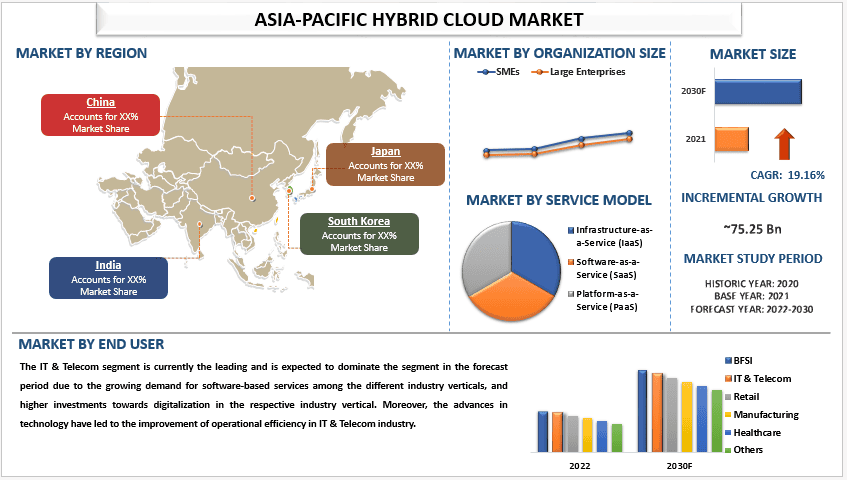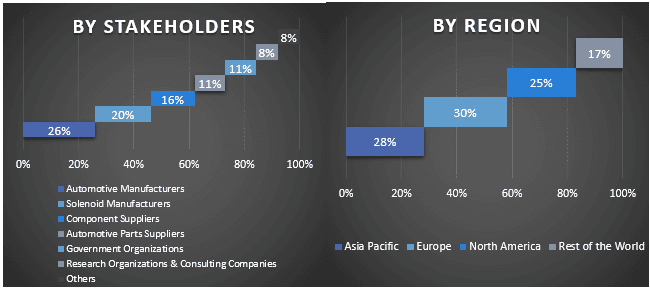- Home
- About Us
- Industry
- Services
- Reading
- Contact Us
Asia-Pacific Hybrid Cloud Market: Current Analysis and Forecast (2023-2030)
Emphasis on Service Model (Infrastructure as a Service, Software as a Service, and Platform as a Service); By Organization Size (SMEs (small and medium enterprises), and large enterprises); End User (BFSI, IT & telecom, retail, manufacturing, healthcare, etc.) and

The Asia-Pacific Hybrid Cloud Market was valued at USD 22.57 billion in 2022 & is expected to grow at a CAGR of 19.16% from 2023-2030. Owing to the growing demand for the automated system. The adoption of hybrid cloud computing solutions among the countries in the Asia-pacific region has gained momentum with the increased focus towards the work-from-home scenario as well as inclination towards the cost reduction measures taken by the different industry verticals.
The economic flexibility and security benefits have also promoted businesses in the Asia-pacific region to opt for hybrid solutions rather than renewing their existing on-premise systems.
As per the Alibaba survey being conducted for the Asia-pacific region, the investment from businesses towards cloud computing solutions is anticipated to rise in the coming years. Various countries with the anticipated percentage increase in investment towards cloud computing are Thailand (93%), Indonesia (94%), the Philippines (91%), Hong Kong SAR (83%), and Singapore (83%).
Various other factors have also instigated the integration of hybrid cloud computing among the businesses in the region, which includes email and productivity, enterprise resource planning, security, file and content storage, and database and data warehousing solutions, etc.
As hybrid cloud storage includes multiple infrastructure environments with unified management systems for easier migration of workload among the shared resources it can easily offer an approximate execution venue for any type of workload as per the customized requirements. Additionally, with a wide portfolio of solutions being offered for business with ease of data storage and sharing, accessing remoting with enhanced security measures, and streamlining the work process the businesses in the Asia-pacific region especially BFSI, IT & telecom, marketing firms, etc., are increasingly adopting hybrid cloud computing solutions.
For instance, In 2022, Google Cloud and PT DCI Indonesia Tbk announced their collaboration for assistance to enterprises to help overcome the challenges related to cloud migration which would be crucial for easier adoption of cloud computing solutions including hybrid cloud. DCI has developed a local hybrid innovation named DCI Database Solution (EDS). The DCI EDS solutions available as managed services on google cloud would allow enterprises with specialized databases.
The respective development easing the adoption of hybrid cloud computing services would be crucial for the upcoming surge in the demand for hybrid cloud computing solutions in the Asia-pacific region during 2023-2030..
Insights Presented in the Report
“Amongst service model, the SaaS segment dominated the market in 2022”
Based on the services model, the market is segmented into Infrastructure as a Service, Software as a Service, and Platform as a Service. Among these, SaaS has a high market share in 2021 and will dominate during the forecast period. This is due to the higher adoption of Software as a Service application for reducing or eliminating upfront costs for IT resources, maintenance costs, and configuration and implementation requirements. Additionally, with enhanced investments towards SaaS have been observed in the major markets in the Asia-pacific region such as India, Singapore, China, Japan, Indonesia, etc., which is further anticipated to propel the demand for hybrid solutions for SaaS.
SaaS solutions offer end-to-end functionality for the BFSI sector for core banking operations by offering virtual machines through secured cloud platforms, server OS, storage management, database administration management, CBS application, maintenance & software patches, etc. In line with the complexities involved with the customers’ information as well as securing a proper payment solution, the BFSI sector has undertaken various measures which include the integration of hybrid cloud solutions for core banking solutions.
For instance, In 2022, the Union Bank of India announced its plans to move its operations and data to a cloud network for improving its scalability. According to the Bank, 70% of the bank’s applications are on the on-premise private network which is anticipated to be shifted to a cloud network in a phased manner in the coming years.
Moreover, various government announcements for digitalization in the countries of the Asia-pacific region would also promote the adoption of cloud computing solutions including the hybrid cloud computing market in the region.
“Amongst organization type, the large enterprise segment dominated the market in 2022”
Based on organization size, the market is segmented into SMEs (small and medium enterprises), and large enterprises. Among these, large enterprises have held a significant market share in the Asia-Pacific Hybrid Cloud Computing Market in 2021. Most of the large institution and businesses including IT service providers, healthcare institutions, banking and financial institutions, government departments, etc., are focusing on digitalization which requires using of cloud-based servers for saving as well as retrieving data from remote locations. With the handling of large volumes of data as well as improving operational efficiency, large enterprises would sustain their higher share in the forecasted period.
Amongst end user, the IT & Telecom segment is currently the leading the market in 2022”
IT & Telecom sector is one of the major sectors which was adversely impacted due to the aftermath of the COVID-19 pandemic. With the emergence of the pandemic and the cessation of transportation and mobility coinciding with the cessation of major economic activities in the region IT & Telecom sector stressed the need to operate its functions remotely by offering the workforce with cloud storage of their operational work. A large number of organizations opted for hybrid and other public cloud networks for remote operations in major emerging economies such as South Korea, India, China, Australia, etc. This has been one of the prime factors that has provided ample thrust to the adoption of hybrid cloud networks in the Asia-Pacific regions..
“China holds the highest market share for the hybrid cloud market in 2022”
China Hybrid Cloud Computing market has witnessed remarkable growth in the Asia-pacific region in the historical years. As COVID-19 pandemic slowed down offline businesses but accelerated the cloud application in China with the emergence of new businesses such as online entertainment and work-from-home. The finance, retail, IT, and entertainment industry are also showing high growth rates in the region with an impressive rise in the average internet-using population, which is promoting the integration of hybrid cloud in the sectors.
Alibaba Cloud, Amazon Web Cloud, Tencent Cloud, and Huawei Cloud are some of the prominent hybrid cloud computing providers in the country that have offered IaaS, PaaS, and SaaS services to customers with emerging needs for industrial cloud platforms and industrial internet, rising expansion of automobile industry, etc.
Asia-Pacific Hybrid Cloud Market Report Coverage

Reasons to buy this report:
- The study includes market sizing and forecasting analysis validated by authenticated key industry experts.
- The report presents a quick review of overall industry performance at one glance.
- The report covers an in-depth analysis of prominent industry peers with a primary focus on key business financials, product portfolios, expansion strategies, and recent developments.
- Detailed examination of drivers, restraints, key trends, and opportunities prevailing in the industry.
- The study comprehensively covers the market across different segments.
- Deep dive regional level analysis of the industry.
Customization Options:
The Asia-pacific hybrid cloud market can further be customized as per the requirement or any other market segment. Besides this, UMI understands that you may have your own business needs, hence feel free to connect with us to get a report that completely suits your requirements.
Table of Content
Research Methodology for the Asia-Pacific Hybrid Cloud Market Analysis (2023-2030)
Analyzing the historical market, estimating the current market, and forecasting the future market of the Asia-Pacific Hybrid Cloud market were the three major steps undertaken to create and analyze the adoption of hybrid cloud in major countries in the region. Exhaustive secondary research was conducted to collect the historical market numbers and estimate the current market size. Secondly, to validate these insights, numerous findings and assumptions were taken into consideration. Moreover, exhaustive primary interviews were also conducted with industry experts across the value chain of the Asia-Pacific hybrid cloud market. Post assumption and validation of market numbers through primary interviews, we employed a top-down/bottom-up approach to forecasting the complete market size. Thereafter, market breakdown and data triangulation methods were adopted to estimate and analyze the market size of segments and sub-segments of the industry pertains to. Detailed methodology is explained below:
Analysis of Historical Market Size
Step 1: In-Depth Study of Secondary Sources:
Detail secondary study was conducted to obtain the historical market size of the Asia-Pacific hybrid cloud market through company internal sources such as annual reports & financial statements, performance presentations, press releases, etc., and external sources including journals, news & articles, government publications, competitor publications, sector reports, third-party database, and other credible publications.
Step 2: Market Segmentation:
After obtaining the historical market size of the Asia-Pacific hybrid cloud market, we conducted a detailed secondary analysis to gather historical market insights and share for different segments & sub-segments for major regions. Major segments are included in the report as service model, by organization size, end user. Further country-level analyses were conducted to evaluate the overall adoption of hybrid cloud in that region.
Step 3: Factor Analysis:
After acquiring the historical market size of different segments and sub-segments, we conducted a detailed factor analysis to estimate the current market size of the Asia-Pacific hybrid cloud market. Further, we conducted factor analysis using dependent and independent variables such as service model, by organization size, end user of the Asia-Pacific hybrid cloud market. A thorough analysis was conducted for demand and supply-side scenarios considering top partnerships, mergers and acquisitions, business expansion, and product launches in the Asia-Pacific hybrid cloud market sector across the region.
Current Market Size Estimate & Forecast
Current Market Sizing: Based on actionable insights from the above 3 steps, we arrived at the current market size, key players in the Asia-Pacific hybrid cloud market, and market shares of the segments. All the required percentage shares split and market breakdowns were determined using the above-mentioned secondary approach and were verified through primary interviews.
Estimation & Forecasting: For market estimation and forecast, weights were assigned to different factors including drivers & trends, restraints, and opportunities available for the stakeholders. After analyzing these factors, relevant forecasting techniques i.e., the top-down/bottom-up approach were applied to arrive at the market forecast for 2030 for different segments and sub-segments across the major markets regionally. The research methodology adopted to estimate the market size encompasses:
- The industry’s market size, in terms of revenue (USD) and the adoption rate of the Asia-Pacific hybrid cloud market across the major markets domestically
- All percentage shares, splits, and breakdowns of market segments and sub-segments
- Key players in the Asia-Pacific hybrid cloud market in terms of products offered. Also, the growth strategies adopted by these players to compete in the fast-growing market
Market Size and Share Validation
Primary Research: In-depth interviews were conducted with the Key Opinion Leaders (KOLs) including Top Level Executives (CXO/VPs, Sales Head, Marketing Head, Operational Head, Regional Head, Country Head, etc.) across major regions. Primary research findings were then summarized, and statistical analysis was performed to prove the stated hypothesis. Inputs from primary research were consolidated with secondary findings, hence turning information into actionable insights.
Split of Primary Participants in Different Regions

Market Engineering
The data triangulation technique was employed to complete the overall market estimation and to arrive at precise statistical numbers for each segment and sub-segment of the Asia-Pacific hybrid cloud market. Data was split into several segments & sub-segments post studying various parameters and trends in the areas of the vehicle type, type, and application in the Asia-Pacific hybrid cloud market.
The main Objective of the Asia-Pacific Hybrid Cloud Market Study
The current & future market trends of the Asia-Pacific hybrid cloud market were pinpointed in the study. Investors can gain strategic insights to base their discretion for investments on the qualitative and quantitative analysis performed in the study. Current and future market trends determined the overall attractiveness of the market at a regional level, providing a platform for the industrial participant to exploit the untapped market to benefit from a first-mover advantage. Other quantitative goals of the studies include:
- Analyze the current and forecast market size of the Asia-Pacific hybrid cloud market in terms of value (USD). Also, analyze the current and forecast market size of different segments and sub-segments
- Segments in the study include areas of the vehicle type, type, and application
- Define and analysis of the regulatory framework for the hybrid cloud industry
- Analyze the value chain involved with the presence of various intermediaries, along with analyzing customer and competitor behaviors of the industry
- Analyze the current and forecast market size of the Asia-Pacific hybrid cloud market for the major region
- Major countries of region studied in the report include China, India, Japan, South Korea and Rest of the Asia-pacific
- Company profiles of the Asia-Pacific hybrid cloud market and the growth strategies adopted by the market players to sustain in the fast-growing market
- Deep dive regional level analysis of the industry
Related Reports
Customers who bought this item also bought










